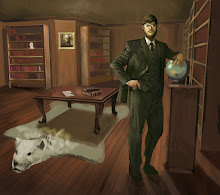Hi everyone, I swear that playing
Elite isn't the only thing I've been doing in the past 2 weeks since last posting links. However, when I've found myself not at work and not doing other productive activities, I've been playing
Elite.
You may recall I mentioned how much I loved this game back in January and I'm here to report that I enjoy it today even more. Rather than babble on about the game, I'll give you a quick screen-cap essay of my latest in-game hobby: Exploration. Do click the images in "embiggen" and enjoy the beauty of
E:D. I apologize that the captions don't appear in the slide show.
You see folks, about 2 weeks back I crashed my primary ship in a very stupid way. I rammed the inside wall of a space station at full afterburn and let's just say Issac Newton is a cruel man.
 |
| F = MA. Rest in pieces. Small, small pieces. |
And with that it was time to put combat and trading on hold and step into the black.
I used this star chart, initially compiled in 1888, to plot a few routes "local" to Earth. For example,
I visited 50 Cassiopeiae using a star chart more than century old.
 |
| Here we see my exploration vessel, the good ship Gladwell, about to set off on my journey. |
 |
| Every star chart humanity has ever made is represented accurately in game and real NASA and ESA data is used to procedurally generate the rest of the galaxy. |
 |
| A lovely quarternary star system. |
 |
| Dropped out of hyperspace right next to this pair and got Gladwell a little cooked. |
 |
| You might notice that the top half of the image has fewer stars than the lower half. I plotted my trip 1000 light years above the galactic horizon hoping I'd find more previously unexplored systems. The sky really thinned out until I turned toward the galactic core. |
 |
| Visiting an ice planet with another lovely image of the galactic center. Still a good 20,000 light years away! |
 |
| An especially black and white gas giant with rings. |
 |
| I found an odd blueish cloud and decided to make my way there. You can also see several nebulae. The galactic core is starting to loom larger. |
 |
| Inside the blue cloud I found this little baddie hiding. You can see the gravitational lens effects of the black hole very clearly. This is the first of many black holes I visited on this trip. |
 |
| A star is about to emerge from behind this gas giant. The rings are also thin enough to allow the galaxy to shine through. On the bottom right you can see our neighboring galaxy, The Magellanic Cloud. Even with in game FTL travel, I don't think it's a manageable distance to travel. 26,000 light years took about 30 hours of playtime for me and that's just one way! |
 |
| Another black hole. I positioned it between myself and the core for a stunning lens effect. |
 |
| Here I am exploring the rings of a Neptune-like gas giant with a dramatic nebula in the background. |
 |
| Inside the nebula, I decided to drop into orbit about this planet and enjoy the view for a while. |
 |
| Before long, I encountered another small cloud in the distance. I suppose these are the remnants of a supernova. I wrote down the name of the system and I'll have to look it up later to see if it is real. |
 |
| Sure enough, this green cloud contained another black hole. More importantly, it was previously undiscovered. I think I'll name it Hubert. |
 |
| After about 30,000 light years of meandering core-ward, I am finally making my last jump into the very center of the Milky Way Galaxy. |
 |
| And here she is, Sagittarius A Star, the supermassive black hole which inhabits the center of our galaxy. The lens effects are far more substantial than the smaller black holes I've encountered previously. You may notice the line of lights on the dorsal ridge of Gladwell, they're heat vents designed to radiate infrared and visible light to cool ship components. Normally they only deploy when jumping (as above) or flying close to a star. Supermassive black holes emit Hawking radiation which is causing the ship to heat up. I don't stick around too long. |
 |
| As I turned for the long journey back home, I encountered this star system about 2000 light years from Sag A*. I guess Gladwell and I will have to investigate this Great Annihilator. |
Anyway, thank you for indulging my gaming posts. I do very much like Elite: Dangerous and after this exploration trip I'm even more enthralled. Interstellar travel isn't something that will happen in my lifetime (or ever, perhaps) and having a game like E:D which seeks to accurately recreate our galaxy for my enjoyment is quite fun.
Okay, back to business. I'll see about posting links later today/this week.





















No comments:
Post a Comment